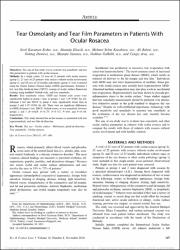| dc.contributor.author | Karaman Erdur, Sevil | |
| dc.contributor.author | Eliaçık, Mustafa | |
| dc.contributor.author | Kocabora, Mehmet Selim | |
| dc.contributor.author | Balevi, Ali | |
| dc.contributor.author | Demirci, Göktuğ | |
| dc.contributor.author | Özsütcü, Mustafa | |
| dc.contributor.author | Gülkılık, Gökhan | |
| dc.contributor.author | Aras, Cengiz | |
| dc.date.accessioned | 10.07.201910:49:13 | |
| dc.date.accessioned | 2019-07-10T19:56:00Z | |
| dc.date.available | 10.07.201910:49:13 | |
| dc.date.available | 2019-07-10T19:56:00Z | |
| dc.date.issued | 2016 | en_US |
| dc.identifier.citation | Karaman Erdur, S., Eliaçık, M., Kocabora, M. S., Balevi, A., Demirci, G. ,Özsütcü, M. ... Aras, C. (2016). Tear osmolarity and tear film parameters in patients with ocular rosacea. Eye & Contact Lens-Science and Clinical Practice, 42(6), 347-349. https://dx.doi.org/10.1097/ICL.0000000000000211 | en_US |
| dc.identifier.issn | 1542-2321 | |
| dc.identifier.issn | 1542-233X | |
| dc.identifier.uri | https://dx.doi.org/10.1097/ICL.0000000000000211 | |
| dc.identifier.uri | https://hdl.handle.net/20.500.12511/2518 | |
| dc.description | WOS: 000387490000002 | en_US |
| dc.description | PubMed ID: 26513720 | en_US |
| dc.description.abstract | Objectives: The aim of this study was to evaluate tear osmolarity and tear film parameters in patients with ocular rosacea. Methods: In a single center, 25 eyes of 25 patients with ocular rosacea (group 1), 25 eyes of 25 patients with rosacea without ocular involvement (group 2), and 20 eyes of 20 healthy individuals (group 3) were evaluated using the Ocular Surface Disease Index (OSDI) questionnaire, Schirmer I test, tear film break-up time (TBUT), scoring of ocular surface fluorescein staining using modified Oxford scale, and tear osmolarity. Results: Tear osmolarity values, OSDI and Oxford scale scores were significantly higher in group 1 than in groups 2 and 3 (P < 0.001 for all). Schirmer I test and TBUT in group 1 were significantly lower than in groups 2 and 3 (P < 0.001 for all). There were no significant differences in OSDI, Schirmer I test, TBUT, Oxford scores, or tear osmolarity between groups 2 and 3 (P = 0.629, P = 0.175, P = 0.713, P = 865, and P = 0.388, respectively). Conclusions: This study showed that ocular rosacea is associated with tear hyperosmolarity and tear film dysfunction. | en_US |
| dc.language.iso | eng | en_US |
| dc.publisher | Lippincott Williams & Wilkins | en_US |
| dc.rights | info:eu-repo/semantics/openAccess | en_US |
| dc.subject | Dry Eye | en_US |
| dc.subject | Ocular Surface | en_US |
| dc.subject | Meibomian Gland Dysfunction | en_US |
| dc.subject | Tear Osmolarity | en_US |
| dc.subject | Ocular Rosacea | en_US |
| dc.title | Tear osmolarity and tear film parameters in patients with ocular rosacea | en_US |
| dc.type | article | en_US |
| dc.relation.ispartof | Eye & Contact Lens-Science and Clinical Practice | en_US |
| dc.department | İstanbul Medipol Üniversitesi, Tıp Fakültesi, Cerrahi Tıp Bilimleri Bölümü, Göz Hastalıkları Ana Bilim Dalı | en_US |
| dc.department | İstanbul Medipol Üniversitesi, Tıp Fakültesi, Dahili Tıp Bilimleri Bölümü, Deri ve Zührevi Hastalıklar Ana Bilim Dalı | en_US |
| dc.authorid | 0000-0001-9829-7268 | en_US |
| dc.authorid | 0000-0001-5335-3860 | en_US |
| dc.authorid | 0000-0001-5057-0405 | en_US |
| dc.authorid | 0000-0002-5079-4713 | en_US |
| dc.authorid | 0000-0001-8954-5055 | en_US |
| dc.authorid | 0000-0002-8047-5553 | en_US |
| dc.identifier.volume | 42 | en_US |
| dc.identifier.issue | 6 | en_US |
| dc.identifier.startpage | 347 | en_US |
| dc.identifier.endpage | 349 | en_US |
| dc.relation.publicationcategory | Makale - Uluslararası Hakemli Dergi - Kurum Öğretim Elemanı | en_US |
| dc.identifier.doi | 10.1097/ICL.0000000000000211 | en_US |
| dc.identifier.wosquality | Q3 | en_US |
| dc.identifier.scopusquality | Q2 | en_US |


















